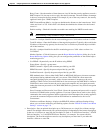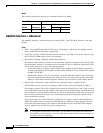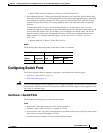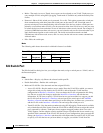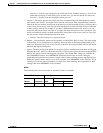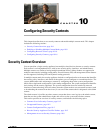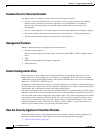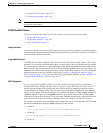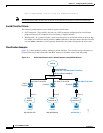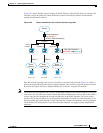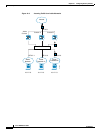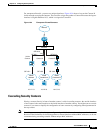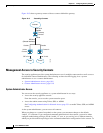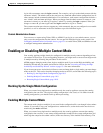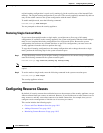
10-3
Cisco ASDM User Guide
OL-16647-01
Chapter 10 Configuring Security Contexts
Security Context Overview
• Invalid Classifier Criteria, page 10-4
• Classification Examples, page 10-4
Note If the destination MAC address is a multicast or broadcast MAC address, the packet is duplicated and
delivered to each context.
Valid Classifier Criteria
This section describes the criteria used by the classifier, and includes the following topics:
• Unique Interfaces, page 10-3
• Unique MAC Addresses, page 10-3
• NAT Configuration, page 10-3
Unique Interfaces
If only one context is associated with the ingress interface, the security appliance classifies the packet
into that context. In transparent firewall mode, unique interfaces for contexts are required, so this method
is used to classify packets at all times.
Unique MAC Addresses
If multiple contexts share an interface, then the classifier uses the interface MAC address. The security
appliance lets you assign a different MAC address in each context to the same shared interface, whether
it is a shared physical interface or a shared subinterface. By default, shared interfaces do not have unique
MAC addresses; the interface uses the physical interface burned-in MAC address in every context. An
upstream router cannot route directly to a context without unique MAC addresses. You can set the MAC
addresses manually when you configure each interface (see the “Configuring an Interface (Single
Mode)” section on page 7-5), or you can automatically generate MAC addresses (see the “Automatically
Assigning MAC Addresses” section on page 10-17).
NAT Configuration
If you do not have unique MAC addresses, then the classifier intercepts the packet and performs a
destination IP address lookup. All other fields are ignored; only the destination IP address is used. To
use the destination address for classification, the classifier must have knowledge about the subnets
located behind each security context. The classifier relies on the NAT configuration to determine the
subnets in each context. The classifier matches the destination IP address to either a static command or
a global command. In the case of the global command, the classifier does not need a matching nat
command or an active NAT session to classify the packet. Whether the packet can communicate with the
destination IP address after classification depends on how you configure NAT and NAT control.
For example, the classifier gains knowledge about subnets 10.10.10.0, 10.20.10.0 and 10.30.10.0 when
the context administrators configure static commands in each context:
• Context A:
static (inside,shared) 10.10.10.0 10.10.10.0 netmask 255.255.255.0
• Context B:
static (inside,shared) 10.20.10.0 10.20.10.0 netmask 255.255.255.0
• Context C:



